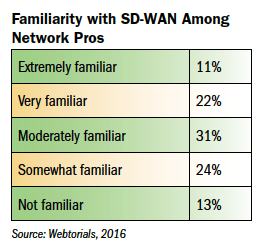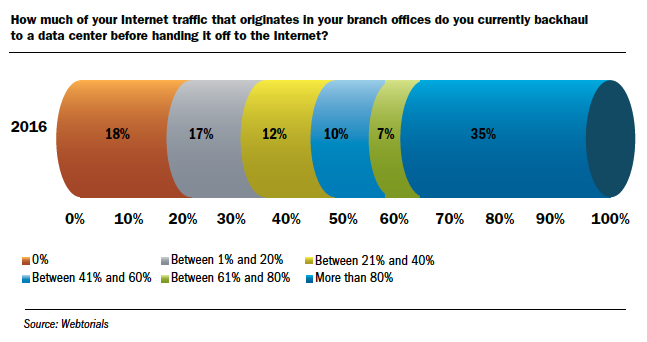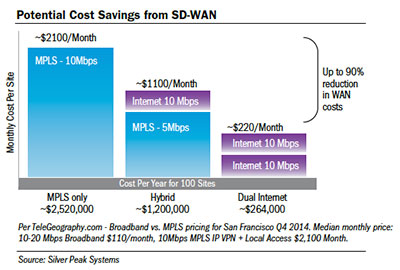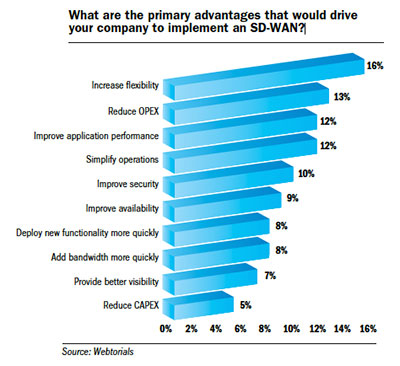Separating the Layers
SD-WAN and its relationship with MPLS
By: Martin Vilaboy

There are some very good reasons why software-defined wide area networking (SD-WAN) currently sits at the peak of Gartner’s 2016 Networking Hype Cycle. The demands placed on the enterprise WAN have changed dramatically during the past several years, and SD-WAN represents the first opportunity for a significant upgrade to wide area network architecture and design since multi-protocol label switching (MPLS) established its dominance more than a decade ago.
Quite simply, whereas traditional WAN architectures, including MPLS, were designed and deployed in an era when applications primarily resided in data centers, SD-WAN provides a new strategy for connecting business users to dispersed and increasingly prevalent cloud- and SaaS-based applications. In other words, if most applications are in the cloud, a dedicated link between a branch office and a company data center could prove redundant. Some proponents of SD-WAN have even posed questions concerning whether or not SD-WAN is a replacement for MPLS.
 The short answer is: no, at least not yet. While SD-WAN can reduce the dependency on MPLS, and may serve as an alternative in some instances, MPLS still provides levels of performance that SD-WAN cannot yet duplicate. What’s more certain, however, SD-WAN does have distinct advantages over MPLS in terms of agility, flexibility and simplicity, all of which are increasingly important to operating networks today and in the future.
The short answer is: no, at least not yet. While SD-WAN can reduce the dependency on MPLS, and may serve as an alternative in some instances, MPLS still provides levels of performance that SD-WAN cannot yet duplicate. What’s more certain, however, SD-WAN does have distinct advantages over MPLS in terms of agility, flexibility and simplicity, all of which are increasingly important to operating networks today and in the future.
SD-WAN, which consolidates and virtualizes the control function of a network into an SDN controller that abstracts the user’s private network services from the underlying IP network, is still a relatively young and emerging architecture. Various surveys suggest about 3 percent to 11 percent of organizations have implemented SD-WAN somewhere within their networks. Gartner this summer estimated that between 500 and 1,000 organizations have purchased and are deploying SD-WAN products. At the same time, strong interest and intent appear to suggest significant uptake could occur in the near term.
 In 2015, for instance, only 15 percent of network professionals surveyed by Webtorials were either very or extremely familiar with the concept of SD-WAN. One year later, bolstered by substantial media coverage and vendor educational efforts, the number of those very or extremely familiar more than doubled to a third of respondents. When asked about their evaluation and implementation plans, 29 percent of network professionals say they are currently actively analyzing the potential value that SD-WAN offers, while another 26 percent say they will likely analyze it sometime in the next year. Just over a third of network professionals either have decided to hold off with plans or have not made any analysis of SD-WAN.
In 2015, for instance, only 15 percent of network professionals surveyed by Webtorials were either very or extremely familiar with the concept of SD-WAN. One year later, bolstered by substantial media coverage and vendor educational efforts, the number of those very or extremely familiar more than doubled to a third of respondents. When asked about their evaluation and implementation plans, 29 percent of network professionals say they are currently actively analyzing the potential value that SD-WAN offers, while another 26 percent say they will likely analyze it sometime in the next year. Just over a third of network professionals either have decided to hold off with plans or have not made any analysis of SD-WAN.
Forrester Consulting, for its part, estimates that about a quarter of telecom and network decision makers at mid-sized to large U.S. enterprises are planning to implement SD-WAN solutions within the next 12 months. That’s on top of the 11 percent that already have implemented and the 15 percent that is expanding implementation. In the near-term, adoption of SD-WAN is set to rise to 50 percent of firms by next year, and in the bigger picture Forester says that “90 percent of network managers are looking to evolve their WAN using a softwaredefined approach.”
Gartner, meanwhile, estimates that 10 percent of enterprises will have replaced their WAN routing with SD-WAN by the end of 2018, while researchers at IHS, Inc. value the market at $1.3 billion by 2020. IDC is much more aggressive, pegging the SD-WAN market at $6 billion by 2020. It noted that nearly 70 percent of organizations expect to use SD-WAN within the next 18 months.
Among the top drivers, according to Webtorials’ findings, are desires to increase flexibility, improve applications performance and reduce operational expenditures while simplifying operations. As
As use of SD-WAN solutions ramp up, it’s certainly likely to exit some traffic off of MPLS networks. For starters, that’s partly because SDN (software defined networking) allows network operators to look to the Internet, or basic broadband connections, as their WAN (or part of it), hence lowering the cost of network operations compared to MPLS.

Consider the issue of “backhauling,” for instance, otherwise known as the “trombone effect.” As Steven Taylor and Jim Metzler of Webtorials explain it, a common approach to designing a branch office WAN is to have T1-based access to a service providers’ MPLS network at each branch office plus one or more high-speed links at each data center. It is not uncommon in this design for a company’s Internet traffic to be backhauled to a data center before being handed off to the Internet. In other words, the Internet-bound traffic transits both the MPLS network and the Internet access link, adding both cost and delay.
RELATED: ChannelVision Report: App-etizing Opportunities
“The penalties associated with backhauling Internet traffic are usually acceptable if the amount of Internet traffic is relatively light,” write the Webtorials analysts. “However, the Internet traffic generated by most companies is large and growing.”
 Again, while MPLS provides a highly stable, high-performance, and highly scalable means of interconnecting multiple data centers and branch offices, it can be expensive, and the expense makes the most sense when applications were largely hosted in data centers and the Internet could not deliver business-grade reliability. Today, applications increasingly are offered on-demand, via the Internet and cloud, and SD-WAN, as a virtual overlay, adds security and reliability to lower-cost broadband connections, say its proponents. One upshot can be a reduced dependency on MPLS connections.
Again, while MPLS provides a highly stable, high-performance, and highly scalable means of interconnecting multiple data centers and branch offices, it can be expensive, and the expense makes the most sense when applications were largely hosted in data centers and the Internet could not deliver business-grade reliability. Today, applications increasingly are offered on-demand, via the Internet and cloud, and SD-WAN, as a virtual overlay, adds security and reliability to lower-cost broadband connections, say its proponents. One upshot can be a reduced dependency on MPLS connections.
That’s not to say SD-WAN eliminates the need for MPLS, at least not in most cases. What SD-WAN does do is bond and support multiple WAN access technologies, such as DSL, LTE, leased lines, MPLS VPN, etc. It creates overlay tunnels on top of available transports links that make up an organization’s WAN, while edge devices at customer sites allow IT administrators to manage or automate, via centralized policies, WAN functionality, including configuration, provisioning and security. Users should also be able to dynamically set the path for each application based on their customer-defined policies.
It’s a benefit that can’t be underestimated as hybrid WAN topologies become the norm. According to one survey by Forrester, for instance, 54 percent of network and telecom managers are dealing with four or more connection technologies within their networks, from private leased lines to carrier Ethernet to 4G/LTE to MPLS to terrestrial fixed wireless. More than three-quarters of firms use more than one, so anything that streamlines management, orchestration and maintenance could be seen as a boon. There is a related business case, as well. Network managers can push less-critical, non-real-time data onto less expensive, best-efforts links, while reserving more expensive, dedicated links for mission-critical and real-time data.
 That’s also where MPLS comes in carrier Ethernet to 4G/LTE to MPLS to terrestrial fixed wireless. More than three-quarters of firms use more than one, so anything that streamlines management, orchestration and maintenance could be seen as a boon.
That’s also where MPLS comes in carrier Ethernet to 4G/LTE to MPLS to terrestrial fixed wireless. More than three-quarters of firms use more than one, so anything that streamlines management, orchestration and maintenance could be seen as a boon.
There is a related business case, as well. Network managers can push less-critical, non-real-time data onto less expensive, best-efforts links, while reserving more expensive, dedicated links for mission-critical and real-time data. That’s also where MPLS comes in (or in the case of our mixed topology, remains in). With MPLS WAN technology, users have full control over traffic engineering. The intelligence in SD-WAN lies on the edge, via boxes on the customer premises that are controlled centrally. SD-WAN solutions can detect and compensate for issues such as packet loss and latency, but its decisions are made by intelligence on the edge. It can automatically choose the best path among all available paths, and if a connection is showing packet loss, jitter or delay, it can choose another path or avoid that one altogether. That’s not the same as ensuring quality of service across the entire route on a best-effort-based broadband link. So it’s likely corporate network managers will choose to keep an MPLS link in parallel with their broadband for more-sensitive, real-time traffic (voice, video), as many SD-WAN providers recommend.
Of course, there is still the opportunity to lower overall cost of network ownership through better utilization of resources. So it would be wise for network pros to understand the benefits of increased flexibility, simplified management and improved security that SD-WAN solutions afford. As networks sprawl across multiple data links, devices and remote employees, it’s no surprise there is exciting about a development that centralizes network control and operations.
All the while, SD-WAN certainly can, and will, lower the dependency on a given access technology and, one could argue, “private” links in general. Buyers will likely use it that way. We’re just not so sure, as yet, that SD-WAN replaces the need for any of them.
VIEW ARTICLE
SUBSCRIBE TO MAGAZINE
About ChannelVision Magazine:
ChannelVision is a bi-monthly digital and print magazine, read by channel partners selling all manner of voice, data, access, managed and business services (both on premise and “in the cloud”), as well as, technology, gear, and equipment. ChannelVision is a highly focused and efficient way for service providers, hardware, and software companies to reach experienced channel partners targeting the small/medium business space. Serving a controlled circulation of providers and indirect distributors of communications, network, IT and cloud-based business services, ChannelVision is telecom’s gateway to perspective on how to adapt, what to sell, and how to sell it.










